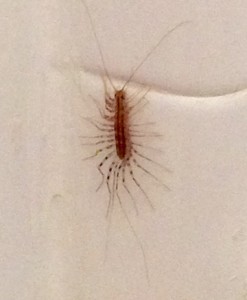I first saw this little cutie in the bathtub. Not being a firm believer in reincarnation, I snuffed it.

Over the following days and weeks, they seemed to be everywhere: medicine cabinet, kitchen floor, toothbrush holder. . . . But no matter how often they ended up like this,

there were always more of them. They were especially noticeable—and challenging—because we weren’t having problems with ants, spiders, flies, etc. Why these critters?
So I did what any scientist would do—I researched the subject. (You do recall that I’m a scientist by training?) The first thing I learned is that my housemates are Scutigera coleoptrata, or common house centipedes. The second thing is that, oddly enough, centipedes don’t exist. Centipedes never have 50 pairs of legs (i.e.,100 legs). Although some species have as many as 191 pairs, all centipede species have an odd number of pairs of legs as normal adults. The common adult house centipede has 15 pairs of legs. Juveniles are shorter and have fewer pairs, adding pairs as they grow.
If you look closely, a centipede is actually beautiful. The legs are long, slender, and thread-like. Their movement is not only fast (1.3 ft. per second) but graceful. On females, the last pair of legs is more than twice as long as the body, which can be up to 1.5 inches. The bodies are long and flat, with three dark racing stripes running head to back.The legs have black and white banding.

One of their most endearing qualities is that they run away from me. But the real reason I have come to love centipedes is that they are good eaters: cockroaches, flies, moths, mosquitos, crickets, silverfish, earwigs, spiders—almost any insect pests. They do kill their prey with venom, but they rarely sting humans and when they do, (I’ve read) it’s much like a mosquito bite. Maybe the reason we aren’t having problems with other insects is that we have our own little squad of live-in exterminators!